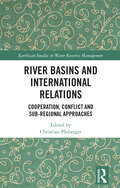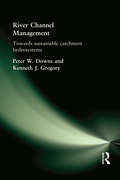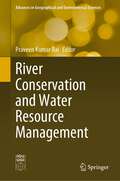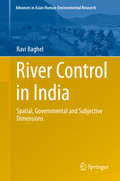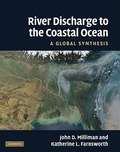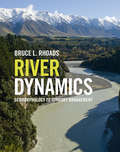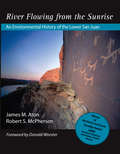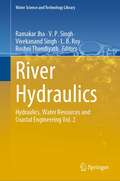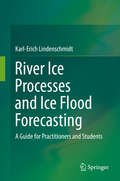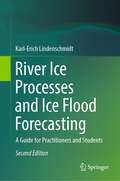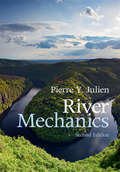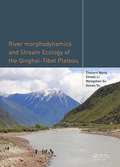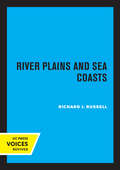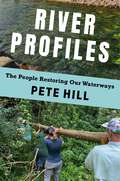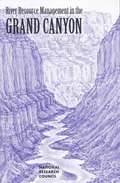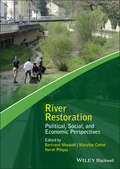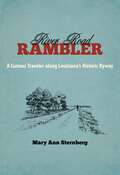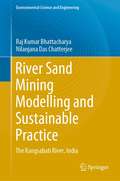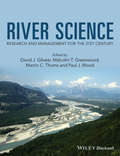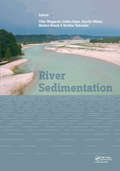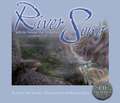- Table View
- List View
River Basins and International Relations: Cooperation, Conflict and Sub-Regional Approaches (Earthscan Studies in Water Resource Management)
by Christian PlobergerThis book argues that river basins represent a particular structural setting in international relations with the potential for generating a dynamic of cooperation among the involved countries. The volume applies the concept of regional cooperation to international river basins to highlight their relevance as a particular space in international relations, emphasizing both the inter-connectivity and transnationalism of international river basins. It addresses the challenges related to resource distribution between up- and down-stream countries, showcasing a variety of examples of cooperation and conflictual relations within various international river basins. Case studies are drawn from across the globe and include the Mekong, the Indus, the Euphrates-Tigris and the Danube international river basins. Each chapter outlines the different aspects which support or undermine cooperation in each case, taking into consideration key areas surrounding resource sharing, national development, environmental considerations and national security. This book will be of great interest to students and scholars with an interest in international river basins, regional cooperation, water resource competition, international relations and environmental politics.
River Channel Management: Towards sustainable catchment hydrosystems
by Peter Downs Ken GregoryRiver Channel Management is the first book to deal comprehensively with recent revolutions in river channel management. It explores the multi-disciplinary nature of river channel management in relation to modern management techniques that bear the background of the entire drainage basin in mind, use channel restoration where appropriate, and are designed to be sustainable.River Channel Management is divided into five sections: ·The Introduction outlines the need for river channel management .·Retrospective Review offers an overview of twentieth century engineering methods and the ways that river channel systems operate. ·Realisation explains how greater understanding of river channel adjustments, channel hazards and river basin planning created a context for twenty-first century management.·Requirements for Management explains and examines environmental assessment, restoration-based approaches, and methods that work towards 'design with nature'·Final Revision speculates about prospects for twenty-first century river channel management. River Channel Management is written for higher-level undergraduates and for postgraduates in geography, ecology, engineering, planning, geology and environmental science, for professionals involved in river channel management, and for staff in environmental agencies.
River Conservation and Water Resource Management (Advances in Geographical and Environmental Sciences)
by Praveen Kumar RaiThis book presents an up-to-date, systematic and scientific analysis of water resource problems in India and suggests measures to overcome them through effective water management. In addition, the book provides an overview of how changes in legislation, policies, institutional responsibilities, science, technology, practical techniques and public perception have influenced the ways of river management over the past years. River water conservation is a planned activity connected with various habitat features and outlines how to conserve all river water spread across the world. The restoration and conservation of river water must be of the highest priority for sustaining humanity and ecology for the present and future generations. In order to solve the water problems, conservation and recycling of water should be made mandatory for all domestic, industrial and agricultural projects. Apart from the priority to watershed development, rainwater harvesting and other appropriate conservation measures should be adopted to create awareness among the public so that their mind-set, attitudes and habits change proactively and they adopt sustainable practices rather than wait for legislation and regulations. The book augments the knowledge base of behaviour of rivers and evaluates the issues related to rivers so as to develop river system management techniques emerging from in-depth scientific analyses. It is useful for students, researchers, water resource managers, hydrologists and all those who are engaged or interested in any aspect of river water conservation and management of water resources in the country.
River Control in India
by Ravi BaghelLarge river systems throughout the planet have been dramatically transformed due to river control projects such as large dams and embankments. Unlike other major human impacts like anthropogenic climate change, the alteration of river systems has been deliberate and planned by a small, powerful set of experts. Taking India as a case study, this book examines the way experts transform the planet through their discourse by their advocacy of river projects. This book identifies the spatial aspects of the norms through which the ideal river and the deficient river in need of control are produced. The role of governmental rationality in explaining the seemingly irrational and counter-productive effects of large projects like Kosi river embankments is considered. Finally using autobiographical material, the subjectivity of expert advice is examined, questioning its presumed objectivity. By examining the different subjective stances arising from the same body of expertise, this book discusses the consequences this has for river control specifically and for the relation between expertise and environmental change in general.
River Discharge to the Coastal Ocean
by John D. Milliman Katherine L. FarnsworthRivers provide the primary link between land and sea. Utilizing the world's largest database, this book presents a detailed analysis and synthesis of the processes affecting fluvial discharge of water, sediment and dissolved solids. The ways in which climatic variation, episodic events, and anthropogenic activities - past, present and future - affect the quantity and quality of river discharge are discussed in the final two chapters. The book contains 26 tables and more than 165 figures - many in full color - including global and regional maps. The book's extensive appendix presents the 1534-river database as a series of 44 tables and 132 maps that provide quantitative data regarding the discharge of water, sediment and dissolved solids. The complete database is also presented within a GIS-based package available online at www.cambridge.org/milliman. River Discharge to the Coastal Ocean provides an invaluable resource for researchers, professionals and graduate students in hydrology, oceanography, geology, geomorphology and environmental policy.
River Dynamics: Geomorphology to Support Management
by Bruce L. RhoadsRivers are important agents of change that shape the Earth's surface and evolve through time in response to fluctuations in climate and other environmental conditions. They are fundamental in landscape development, and essential for water supply, irrigation, and transportation. This book provides a comprehensive overview of the geomorphological processes that shape rivers and that produce change in the form of rivers. It explores how the dynamics of rivers are being affected by anthropogenic change, including climate change, dam construction, and modification of rivers for flood control and land drainage. It discusses how concern about environmental degradation of rivers has led to the emergence of management strategies to restore and naturalize these systems, and how river management techniques work best when coordinated with the natural dynamics of rivers. This textbook provides an excellent resource for students, researchers, and professionals in fluvial geomorphology, hydrology, river science, and environmental policy.
River Flowing From The Sunrise: An Environmental History of the Lower San Juan
by James M Aton Robert McPhersonThe authors recount twelve millennia of history along the lower San Juan River, much of it the story of mostly unsuccessful human attempts to make a living from the river's arid and fickle environment. From the Anasazi to government dam builders, from Navajo to Mormon herders and farmers, from scientific explorers to busted miners, the San Juan has attracted more attention and fueled more hopes than such a remote, unpromising, and muddy stream would seem to merit.
River Flowing from the Sunrise
by Robert S. Mcpherson James M. AtonThe authors recount twelve millennia of history along the lower San Juan River, much of it the story of mostly unsuccessful human attempts to make a living from the river's arid and fickle environment. From the Anasazi to government dam builders, from Navajo to Mormon herders and farmers, from scientific explorers to busted miners, the San Juan has attracted more attention and fuelled more hopes than such a remote, unpromising, and muddy stream would seem to merit.
River Health Assessment: A Study on Mahananda River, India (Springer Geography)
by Suman Mitra Lakpa Tamang Sunil Kumar DeThis book provides in detail assessment of the health of Mahananda river, an important head water river system in the Darjeeling Sub-Himalayas which is getting altered rapidly with the pace of human interference. It covers all aspects of river health monitoring through an effective method combining geospatial analysis and field measurements for the assessment of the hydromorphological, hydrochemistry, and hydrobiological quality which indicates that it is neither maintaining its overall fluvial characteristics and functions, nor can quickly replenish, supporting local biota and sediment transport. This book also identifies the factors responsible for existing health condition and suggests target-oriented restoration measures for the sustenance of river health essential for restoring the hydro-ecological balance of one of the most degraded river. The book can be utilized as reference materials by academics, practitioners, and decision-makers for the health assessment of other river basins.
River Health and Ecology in South Asia: Pollution, Restoration, and Conservation
by Gouri Sankar Bhunia Pravat Kumar Shit Bidhan Chandra Patra Manojit BhattacharyaThis volume reviews recent hydrological and environmental issues resulting from human-induced water pollution practices while providing case studies on the physical, chemical, and eco-biological techniques used to mitigate the impacts of river ecosystem pollution in South Asian countries. The book demonstrates the key methods of measurement, monitoring, mapping, and modeling of river water quality and how it is impacted by pollution and incorporates contemporary geospatial technological applications for the management and sustainability of future water resources. The major topics that the book addresses are the fundamental concepts of river ecosystem health, riverine ecology and habitats, risk assessment of riverine pollution, and technology-based river pollution control strategies. The book will serve as an interdisciplinary guide for researchers, students, and GIS specialists working in various disciplines, including pollution hazards, river ecosystem restoration, water quality, remote sensing, zoology, natural resources management, and environmental geography.
River Hydraulics: Hydraulics, Water Resources and Coastal Engineering Vol. 2 (Water Science and Technology Library #110)
by V. P. Singh Ramakar Jha Vivekanand Singh L. B. Roy Roshni ThendiyathThis book presents key principles of the hydraulics of river basins, with a unique focus on the interplay between stream flows and sediment transport. Addressing a number of basic topics related to the hydraulics of river systems, above all it emphasizes applicative aspects in order to provide the reader with a solid grasp of river engineering. The understanding of the river hydraulics is essential for the assessment of optimum locations for the conservation of water resources and its structures. This book will be interesting to readers and researchers working in the specialized area of river hydraulics of Ganga basin, Narmada, Tapi, Godavari, and other basins of India. It consists of review on hydraulics of meandering river; hydraulic design of reservoir in permeable pavement; optimization of hydraulic design; hydraulic investigations to optimize the design of spillway and design of energy dissipater; and analysis of performance of orifice spillway using computational fluid dynaics
River Ice Processes and Ice Flood Forecasting: A Guide for Practitioners and Students
by Karl-Erich LindenschmidtThis book exposes practitioners and students to the theory and application of river and lake ice processes to gain a better understanding of these processes for modelling and forecasting. It focuses on the following processes of the surface water ice: freeze-up, ice cover thickening, ice cover breakup and ice jamming. The reader will receive a fundamental understanding of the physical processes of each component and how they are applied in monitoring and modelling ice covers during the winter season and forecasting ice floods. Exercises accompany each component to reinforce the theoretical principles learned. These exercises will also expose the reader to different tools to process data, such a space-borne remote sensing imagery for ice cover classification. A thread supporting numerical modelling of river ice and lake ice processes runs through the book.
River Ice Processes and Ice Flood Forecasting: A Guide for Practitioners and Students
by Karl-Erich LindenschmidtThis book exposes practitioners and decision-makers to the theory and application of river ice processes to gain a better understanding of these processes for modelling and ice flood hazard and risk assessment. It focuses on the following processes of the surface water ice: river freeze-up and flooding, mid-winter ice-cover breakup and flooding and end-of-winter ice-cover breakup and ice jamming. The reader will receive a fundamental understanding of the physical processes of each component and how they are applied in monitoring, modelling and flood hazard/risk assessment of river ice during the entire winter season, from freeze-up to potential mid-winter breakup and concluding with springtime ice-cover breakup and ice-jam flooding. Spreadsheet, geographical information system (GIS) and modelling exercises accompany each component to reinforce the theoretical principles learned. Step-by-step tutorial videos allow the reader to better engage with the book and learn the material faster.
River Mechanics (2nd Edition)
by Pierre Y. JulienThe second edition of Julien's textbook presents an analysis of rivers from mountain streams to river estuaries. The book is rooted in fundamental principles to promote sound engineering practice. <P><P>State-of-the-art methods are presented to underline theory and engineering applications. River mechanics blends the dual concepts of water conveyance and sediment transport. Like the first edition, this textbook contains ample details on river equilibrium, river dynamics, bank stabilization, and river engineering. Complementary chapters also cover the physical and mathematical modeling of rivers. As well as being completely updated throughout, three new chapters have been added on watershed dynamics, hillslope stability, and stream restoration. Throughout the text, hundreds of examples, exercises, problems, and case studies assist the reader in learning the essential concepts of river engineering. The textbook is very well illustrated to enhance advanced student learning, while researchers and practitioners will find the book to be an invaluable reference.<P> Presents a detailed analysis of rivers from the mountains to the oceans: readers will benefit from an integrated view of rivers rather than a fragmented stream versus rivers approach,<P> Numerous worked examples, data sets, exercises, and solved problems will help advanced students and researchers in their understanding of river mechanics,<P> The second edition has been brought completely up-to-date, with new sections on hillslope stability, river meandering, and stream restoration, providing readers with a broader base for the analysis of rivers and environmental considerations,.
River Morphodynamics and Stream Ecology of the Qinghai-Tibet Plateau
by Zhaoyin Wang Zhiwei Li Mengzhen Xu Guoan YuThis book focuses on the river morphodynamics and stream ecology of the Qinghai-Tibet Plateau. The objective of the book is to summarize and synthesize the recent studies based on field surveys undertaken in the period 2007-2014. This book was written to serve as a graduate-level text for a course in river dynamics and stream ecology and as a refer
River Networks as Ecological Corridors: Species, Populations, Pathogens
by Andrea Rinaldo Marino Gatto Ignacio Rodriguez-IturbeRiver networks are critically important ecosystems. This interdisciplinary book provides an integrated ecohydrological framework blending laboratory, field, and theoretical evidence that changes our understanding of river networks as ecological corridors. It describes how the physical structure of the river environment impacts biodiversity, species invasions, population dynamics, and the spread of waterborne disease. State-of-the-art research on the ecological roles of the structure of river networks is summarized, including important studies on the spread and control of waterborne diseases, biodiversity loss due to water resource management, and invasions by non-native species. Practical implications of this research are illustrated with numerous examples throughout. This is an invaluable go-to reference for graduate students and researchers interested in river ecology and hydrology, and the links between the two. Describing new related research on spatially-explicit modeling of the spread of waterborne disease, this book will also be of great interest to epidemiologists and public health managers.
River Plains and Sea Coasts
by Richard J. RussellThis title is part of UC Press's Voices Revived program, which commemorates University of California Press’s mission to seek out and cultivate the brightest minds and give them voice, reach, and impact. Drawing on a backlist dating to 1893, Voices Revived makes high-quality, peer-reviewed scholarship accessible once again using print-on-demand technology. This title was originally published in 1967.
River Profiles: The People Restoring Our Waterways
by Pete HillCenturies of mismanagement and destructive development have gravely harmed American waterways, with significant consequences for the ecosystems and communities built around them. But a range of passionate and committed people have stepped up to restore streams and rivers around the United States. A husband-and-wife scientist team in Pennsylvania lead projects to unclog the sediment left by early colonists’ dams. Members of the Tulalip Tribes in western Washington State bring beavers back to headwater streams. A public servant in Milwaukee drives the sewer department to remove concrete channels and reduce flood risk. Community activists in Atlanta push for environmental justice in river restoration.Telling these stories and many more, Pete Hill—a twenty-year veteran of the field of watershed restoration—provides a deep dive into the world of river and stream conservation. He profiles the practitioners, scientists, and activists from all walks of life who take part in restoration efforts, exploring their differing, sometimes controversial approaches. Through their stories, Hill illustrates the challenges and rewards of river restoration and the evolving scientific understanding in the field. Underscoring the need for a variety of strategies adapted to different local contexts, he shows that new ideas have come from a wide range of people—from those operating the machinery to those researching stream ecology—and that Indigenous knowledge offers vital resources. At once personal and learned, insightful and inspiring, this book shines a light on the people working to heal our streams and rivers.
River Resource Management in the Grand Canyon
by Committee to Review the Glen Canyon Environmental StudiesFederal management of water is undergoing a change that involves a drastic reduction in the number of new water projects and an increase in emphasis on the quality of water management. This book summarizes and analyzes environmental research conducted in the lower Colorado River below the Glen Canyon Dam under the leadership of the Bureau of Reclamation. It reviews alternative dam operations to mitigate impacts in the lower Colorado riverine environment and the strengths and weaknesses of large federal agencies dealing with broad environmental issues and hydropower production. While many problems remain to be solved, the Bureau of Reclamation through the Glen Canyon area. The lessons of GCES are transferable to other locations and could be the basis for a new era in the management of western waters.
River Restoration: Political, Social, and Economic Perspectives (Advancing River Restoration and Management)
by Hervé Piégay Bertrand Morandi Marylise CottetRiver Restoration River restoration initiatives are now widespread across the world. The research efforts undertaken to support them are increasingly interdisciplinary, focusing on ecological, chemical, physical as well as societal issues. River Restoration: Political, Social, and Economic Perspectives provides a comprehensive overview of research in the field of river restoration in humanities and the social sciences. It illustrates how, in the last thirty years or so, such approaches have evolved and strengthened within the restoration sciences. The scientific community working in this domain has structured itself, often regionally and circumstantially, to critically assess and improve restoration policies and practices. As a research field, river restoration tackles three thematic axes: Human-river interactions – especially perceptions and practices of rivers, and how these interactions can be changed by restoration projects Political processes, with a particular interest in governance and decision-making, and a specific emphasis on the question of public participation in restoration projects Evaluation of the social and economic benefits of river restoration River Restoration: Political, Social, and Economic Perspectives encompasses these three topics, and more, to provide the reader with the most up-to-date and holistic view of this constantly evolving area. The book will be of particular interest to human and social scientists, biophysical scientists (hydrologists, geomorphologists, ecologists), environmental scientists, public policy makers, design or planning officers, and anyone working in the field of river restoration.
River Road Rambler: A Curious Traveler along Louisiana's Historic Byway (Southern Literary Studies)
by Mary Ann SternbergThe River Road between New Orleans and Baton Rouge hosts a fascinating mix of people, traditions, and stories. Author Mary Ann Sternberg has spent over two decades exploring this historic corridor, uncovering its intriguing and often-underappreciated places. In River Road Rambler, she presents fifteen sketches about sites along this scenic route. From familiar stops, such as the National Hansen's Disease Center Museum at Carville and the perique tobacco area of St. James Parish to lesser-known attractions such as Our Lady of Lourdes grotto in the town of Convent and the Colonial Sugars Historic District, Sternberg provides a new perspective on some of the region's most colorful places. While many of these locales remain easily accessible to any River Road rambler, Sternberg also depicts others closed to the public, giving armchair travelers an introduction to these otherwise unreachable attractions. Throughout, Sternberg captures the ambiance of her surroundings with a clear, engaging, and personal examination of the relationships between past and present. In a poignant piece on the garden of "Valcour" Aime, for example, she delves into the history of this lavish, nationally acclaimed planter's garden, established and abandoned in the mid-nineteenth century. Her visit to the now-private and protected site, which has never been altered or replanted, uncovers an extraordinary landscape -- the relic of what Aime created, slowly overwhelmed by nature. These sketches brim with insights and observations about everything from the fire that razed The Cottage plantation to the failed attempts to salvage the reproduction of the seventeenth-century French warship Le Pelican from the bottom of the Mississippi. River Road Rambler links us to both past and present while revealing delightful and unexpected surprises only found along this storied byway.
River Sand Mining Modelling and Sustainable Practice: The Kangsabati River, India (Environmental Science and Engineering)
by Nilanjana Das Chatterjee Raj Kumar BhattacharyaWorldwide demand for sand and gravel is increasing daily, as the need for these materials continues to rise, for example in the construction sector, in land filling and for transportation sector based infrastructural projects. This results in over-extraction of sand from channel beds, and hampers the natural renewal of sediment, geological setup and morphological processes of the riverine system. In India, illegal sand mining (of alluvial channels) and gravel mining (of perennial channels) are two anthropogenic issues that negatively affect the sustainable drainage system. Along the Kangsabati River in India, the consequences of sand mining are very serious. The construction of Mukutmonipur Dam (1958) on the river causes huge sediment deposition along the middle and downstream areas, these same areas are also intensely mined for sand (instream and on the flood plain). Geospatial models are applied in order to better understand the state and the resilience of stream hydraulics, morphological and river ecosystem variables during pre-mining and post-mining stages, using micro-level datasets of the Kangsabati River. The book also includes practicable measures to minimize the environmental consequences of instream mining in respect to optimum sand mining. It discusses the threshold limits of each variable in stream hydraulics, morphological and river ecological regime, and also discusses the most affected variables. Consequently, all outputs will be very useful for students, researchers, academicians, decision makers and practitioners and will facilitate applying these techniques to create models for other river basins.
River Science: Research and Management for the 21st Century
by David J. Gilvear Malcolm T. Greenwood Martin C. Thoms Paul J WoodRiver Science is a rapidly developing interdisciplinary field at the interface of the natural sciences, engineering and socio-political sciences. It recognises that the sustainable management of contemporary rivers will increasingly require new ways of characterising them to enable engagement with the diverse range of stakeholders.This volume represents the outcome of research by many of the authors and their colleagues over the last 40 years and demonstrates the integral role that River Science now plays in underpinning our understanding of the functioning of natural ecosystems, and how societal demands and historic changes have affected these systems. The book will inform academics, policy makers and society in general of the benefits of healthy functioning riverine systems, and will increase awareness of the wide range of ecosystem goods and services they provide.
River Sedimentation: Proceedings of the 13th International Symposium on River Sedimentation (Stuttgart, Germany, 19-22 September, 2016)
by Silke Wieprecht Stefan Haun Karolin Weber Markus Noack Kristina TerheidenSediment dynamics in fluvial systems is of great ecological, economic and human-health-related significance worldwide. Appropriate management strategies are therefore needed to limit maintenance costs as well as minimize potential hazards to the aquatic and adjacent environments. Human intervention, ranging from nutrient/pollutant release to physical modifications, has a large impact on sediment quantity and quality and thus on river morphology as well as on ecological functioning. Truly understanding sediment dynamics requires as a consequence a multidisciplinary approach.River Sedimentation contains the peer-reviewed scientific contributions presented at the 13th International Symposium on River Sedimentation (ISRS 2016, Stuttgart, Germany, 19-22 September 2016), and includes recent accomplishments in theoretical developments, numerical modelling, experimental laboratory work, field investigations and monitoring as well as management methodologies.
River Song with The Banana Slug String Band
by Steve Van ZandtA river is a wonderful thing, from the trickle of snowmelt to the ocean, and from icy winter through a warm autumn--and is celebrated in this volume through illustrations, verse and a song by a popular children's band.
